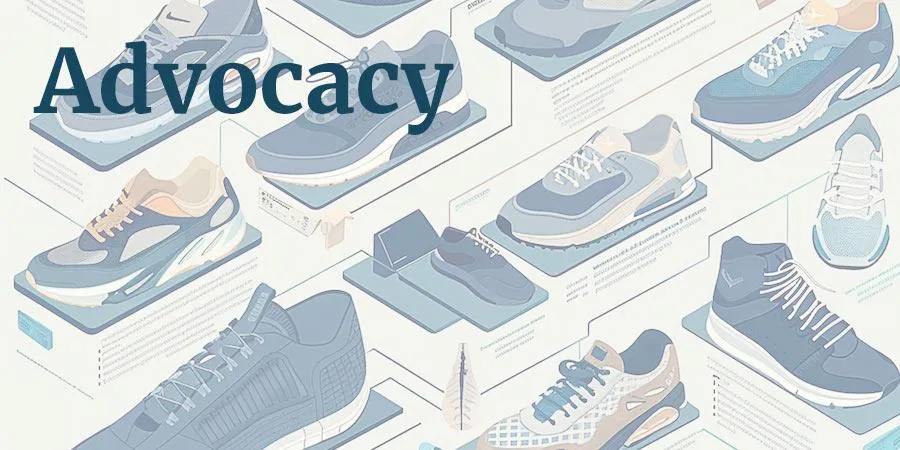Advocacy
Explore practical advice and strategies on family budgeting, saving, and financial planning to empower families globally with the tools they need to achieve financial stability and security.

Step Change: The Footwear Industry’s Journey to Inclusivity
The journey toward inclusivity within the footwear industry is a notable reflection of significant cultural and commercial transformations that mirror wider societal calls for diversity and accessibility. Traditionally, the industry largely catered to a 'standard' size, sidelining individuals with unique or specific needs, thereby reinforcing exclusionary practices prevalent within fashion. The recent decades, however, have experienced a transformative advocacy for inclusivity. This is championed by emerging market entrants and a shift in consumer expectations, which have effectively challenged and expanded the industry's norms regarding standardization.
It represents a deeper recognition of individual consumer identities and the spectrum of their needs. It incorporates designs that are adaptive and cater specifically to individuals with disabilities, merging style with functionality seamlessly. Furthermore, this inclusivity addresses the real disparities in foot shapes and sizes across populations, recognizing these variations not as anomalies but as aspects of normal human diversity. This evolving recognition is shaping up not just as a market trend but as a fundamental shift in the fashion industry’s values, reflecting a broader commitment to equality and accessibility.

Key Takeaways
Historical Context of Exclusivity
For years, the footwear industry has clung to a one-size-fits-all mentality, often ignoring the diverse and unique needs of its expansive clientele. This traditional perspective has consistently excluded individuals whose shoe sizes fall outside the so-called 'standard' range, leaving them with few options for comfortable, well-fitting footwear. This exclusion not only highlights a significant oversight in addressing the full spectrum of consumer needs but also underscores a broader issue of accessibility within the industry.
The reality is that feet, much like people, come in a myriad of shapes and sizes. To presume that a limited range of sizes can accommodate such variation is not only unrealistic but also inherently dismissive of the individual's quest for shoes that don't just fit, but fit well and feel good. The discomfort and frustration of trying to fit into an ill-suited pair of shoes can be more than just a minor inconvenience; it can affect one's quality of life, self-esteem, and overall well-being.
Thankfully, the tide appears to be turning. Prompted by a louder, more diverse array of consumer voices, the industry has begun to awaken to the reality of its past failings. This burgeoning awareness is fueled by calls for greater inclusivity and the recognition that all consumers, regardless of their size, deserve to have their needs met with the same level of care, consideration, and excellence.
This shift towards inclusivity represents more than just an expansion of size ranges; it signifies a fundamental change in how the footwear industry views and values its customers. It's an acknowledgment that everyone deserves the right to comfortable, stylish, and well-fitting shoes—a notion that, while overdue, is a welcome change.
As this transformation unfolds, it's clear that the demand for inclusivity is not a passing trend but a permanent and necessary evolution. The industry's move to embrace a more diverse array of sizes and fits is a testament to the power of consumer advocacy and the importance of listening to and valuing every customer's experience. This shift not only benefits those who have long been marginalized by the industry's narrow sizing standards but also enriches the footwear market as a whole, introducing a wealth of opportunities for innovation, customization, and growth.
In embracing this new direction, the shoe industry can begin to repair its relationship with those it has previously overlooked, building a future where everyone can step out in comfort and style, confident in the knowledge that their needs are not just recognized but celebrated.

Current Innovations Driving Inclusivity
In recent years, the journey towards creating more inclusive footwear options has witnessed a remarkable transformation, thanks in large part to groundbreaking technological innovations and a deeper comprehension of the varied needs of consumers across the spectrum. The advent of cutting-edge technologies such as 3D printing and the integration of advanced AI-driven design algorithms have revolutionized the way shoes are conceived, designed, and produced. These technological leaps have made it possible to offer personalized footwear solutions that were once considered impractical or too costly to pursue from both logistical and financial perspectives.
The capabilities of 3D printing technology, for instance, have opened up a new world of possibilities in shoe manufacturing. This technology allows for the precise construction of shoes that perfectly adhere to the individual's foot shape and size, offering unparalleled comfort and fit. Similarly, AI-driven design algorithms can analyze vast amounts of data regarding foot shapes, sizes, and movement patterns, enabling designers to create shoes that not only fit better but also cater to specific functional needs and preferences.
Today's footwear companies have grown increasingly adept at leveraging these technologies to produce shoes that cater to a wide array of consumer demands. Beyond just achieving an ideal fit, they are now able to incorporate materials and structural designs that specifically address various mobility challenges. This capability significantly expands the range of consumers who can find comfortable and supportive shoes, making strides toward a more inclusive market.
Moreover, these technological advancements have not only expanded the accessibility of custom-fit and functional footwear but have also introduced a new level of personalization in the industry. Consumers are no longer limited to off-the-shelf options that may or may not meet their needs. Instead, they have the opportunity to be actively involved in the creation of their footwear, ensuring that the final product is tailored to their exact specifications and requirements.
This evolution towards more inclusive footwear is a testament to how technology can bridge gaps between diverse consumer needs and the products available in the market. It reflects a growing understanding within the industry that inclusivity extends beyond mere sizing; it encompasses the need to address a variety of functional and mobility considerations, making quality footwear accessible to everyone, regardless of their unique challenges.
As we look to the future, it is evident that the intersection of technology and consumer-centric design will continue to play a pivotal role in shaping the footwear industry. The commitment to inclusivity, driven by technological innovations, not only enriches the consumer experience but also paves the way for a more adaptive and responsive industry. This ongoing transformation promises a future where everyone can enjoy the benefits of shoes designed with their specific needs in mind, marking a significant step forward in the quest for comprehensive market inclusivity.

Projecting the Future of Inclusive Footwear
As we look towards the horizon of the footwear industry, a promising trend is emerging that marries inclusivity with sustainability. This shift is indicative of a broader movement within the industry towards embracing environmental responsibility and ethical production methods. The anticipated advancements in this sphere are not only exciting for their potential to revolutionize how we think about and produce shoes but also for their promise in leading the charge towards a more sustainable and inclusive future.
One of the key developments on this front is the significant increase in the use of biodegradable materials within footwear manufacturing. This move towards materials that can naturally decompose at the end of their life cycle represents a major stride in reducing the environmental footprint of shoes. Similarly, the adoption of eco-friendly production techniques showcases an industry committed to minimizing its impact on the planet. These methods not only lessen pollution and conserve resources but also set a new standard for how ethical manufacturing can and should be approached in the 21st century.
These sustainable practices are expected to go hand in hand with the advancements in customization technology that have been making waves in the industry. Technologies such as 3D printing and AI-driven design have been pivotal in creating footwear that caters to the unique needs and preferences of individuals, offering unprecedented levels of personalization in terms of fit, style, and functionality. The integration of sustainable materials and methods into this customization process further enhances the value proposition of these innovations. By doing so, it's not just the personalization of footwear that's advanced but also the efficiency of production processes, leading to a significant reduction in waste. This synergy between consumer-centric innovation and sustainability is a testament to the industry's ability to evolve in ways that are both forward-thinking and mindful of the planet.
This evolving landscape of the footwear industry, where inclusivity meets sustainability, is not just a win for consumers looking for personalized and eco-conscious options but also a significant step forward in the industry's contribution to global sustainability efforts. It reflects a growing recognition of the importance of environmental stewardship and social responsibility in every aspect of production and consumption.
As these trends continue to unfold, they signal a transformation in the footwear industry that could serve as a blueprint for other sectors. The commitment to combining inclusivity with sustainability shows a path forward that does not compromise on quality, innovation, or ethical standards. It's a compelling vision of the future, one where the shoes we wear are not only tailored to fit our feet but also designed to leave a lighter footprint on the earth.

Challenges in Traditional Footwear Design
The traditional shoe manufacturing process has been a barrier to achieving inclusivity. The industry's reliance on standardized molds and sizes, efficient for mass production, doesn't meet the diverse needs of consumers. This one-size-fits-all approach has excluded many individuals, particularly those with unique foot shapes or specific needs, leaving them with limited footwear options. This issue goes beyond inconvenience, highlighting a deep-rooted industry practice that favors economies of scale over individual consumer needs and diversity. Mass production's focus has sidelined the making of varied shoe batches to cater to all consumer needs, prioritizing cost-effectiveness over inclusivity and satisfaction. This has fostered a cycle of exclusivity, reflecting the industry's hesitance to adopt innovative methods that acknowledge the diversity of human bodies. The lack of suitable options for those with non-standard sizes sends a message that their needs are lesser. This not only affects their ability to find comfortable shoes but also impacts their sense of inclusion and recognition in the market.
To break from this cycle, shoe manufacturers must fundamentally change their production philosophy. Shifting from a one-size-fits-all approach to a model that's inclusive, adaptable, and focused on the consumer is crucial. Such a change would not only broaden the variety of available footwear but also demonstrate a commitment to meeting the diverse needs of all consumers. Embracing this change is vital for creating an industry that values each consumer's uniqueness, ensuring they receive the respect and attention they deserve throughout the production and design process.

Breakthrough Moments in Inclusive Footwear
The move toward creating more inclusive footwear options marks a transformative period in the shoe industry, highlighted by several key innovations. Among these, the introduction of 3D foot scanning technology stands out as a game-changer. This cutting-edge technology offers a detailed analysis of individual foot shapes, enabling manufacturers to produce shoes that fit the contours of a person's feet with unprecedented accuracy. The result is footwear that not only fits better but also offers enhanced support and comfort, potentially improving the wearer's overall health and well-being. This is particularly beneficial for individuals with unique foot shapes or conditions that have previously made finding comfortable shoes a challenge.
In parallel with technological advancements, strides in material science have significantly contributed to the evolution of inclusive footwear. Researchers and developers have introduced innovative materials that are both flexible and durable, capable of accommodating various foot conditions while maintaining the shoe's aesthetic appeal. These materials have the ability to stretch, breathe, and conform to different foot shapes, ensuring that the shoes are not just functional but also stylish. This blend of function and fashion is crucial in making inclusive footwear appealing to a broad audience, ensuring that no one has to compromise style for comfort.
Moreover, these advancements in both technology and materials underscore a broader commitment within the industry to meet the needs of all consumers, regardless of their foot shape or size. By prioritizing comfort, health, and style, the footwear industry is taking significant steps toward dismantling barriers to inclusivity. This proactive approach not only enhances the shopping experience for individuals with specific footwear needs but also sets a new standard for how products can be developed with an eye toward universal design principles. As a result, the shift towards more inclusive footwear is not just about improving individual products; it's about reshaping the industry's understanding of and approach to diversity, ensuring everyone can find shoes that fit well and look great.

Designers at the Forefront
Interacting closely with footwear designers unveils a profound dedication to achieving inclusivity within the industry, a commitment that frequently originates from their firsthand encounters with the limitations and biases of traditional shoe manufacturing practices. These innovative designers, driven by a desire to make a significant difference, actively seek out and incorporate insights and feedback from groups that have been largely neglected by the mainstream footwear market. This approach is not just about making minor adjustments to existing products; it's about rethinking design from the ground up to ensure that the resulting footwear genuinely meets the diverse needs of all potential wearers.
This commitment to inclusivity is not merely a business strategy but a personal mission for many designers. Their dedication often stems from witnessing the challenges faced by individuals who struggle to find shoes that cater to their unique needs—be it due to size, shape, or specific health conditions. By engaging directly with these communities, designers gain a deeper understanding of the gaps in the market and the real-world impact of those gaps on people's lives. This empathetic approach fuels their passion to create solutions that are not only innovative but also deeply rooted in the real needs of underserved populations.
Furthermore, this process of integration and feedback collection is a continuous loop. Designers don't just listen once and move on; they maintain an ongoing dialogue with these communities to ensure their offerings remain relevant and truly beneficial. This iterative approach allows for the constant refinement of designs, ensuring that inclusivity in footwear evolves beyond a mere trend and becomes a lasting hallmark of the industry. Through this dedicated effort, footwear designers are not just creating shoes; they're fostering a more inclusive culture within the fashion world, proving that thoughtful design can lead to meaningful change for individuals who have long been overlooked by traditional retail models.
In essence, the move towards inclusivity in footwear design is a testament to the power of empathy and innovation in addressing long-standing industry challenges. It symbolizes a shift towards a more equitable and responsive approach to fashion, where the needs of all consumers, regardless of their unique characteristics, are not just recognized but celebrated.

Reshaping Industry Norms Through Inclusive Design
The ongoing shift towards inclusive footwear is significantly reshaping both industry norms and broader societal expectations of fashion. This movement challenges entrenched beliefs about who fashion is intended for and its functional roles, advocating a more inclusive model where fashion serves everyone equitably. This paradigm shift addresses the immediate needs of a diverse consumer base and sets a new standard for other industries to emulate.
Wide Fit World
Advancing Inclusivity in Footwear
©2024 Wide Fit World All rights reserved.
Wide Fit World is a 1901 French Association
RNA: W922021046
3 rue Voltaire, La Garenne-Colombes, 92250, France
We advocate for inclusive footwear fashion, urging the industry to embrace diverse foot shapes. Through advocacy and collaboration, we strive for a future where comfort and style coexist, ensuring every step counts towards inclusive design innovation
Join our newsletter
*We will get back to you shortly
Google Ads Disclaimer: This disclaimer states there is no guarantee of specific results and each person's results may vary. The information on this site is not intended or implied to be a substitute for professional advice or consultation on the subject. All content, including text, graphics, images, and information, contained on or available through this website is for general information purposes only.
Wide Fit World makes no representation and assumes no responsibility for the accuracy of information contained on or available through this website, and such information is subject to change without notice. You are encouraged to confirm any information obtained from or through this website with other sources.
Wide Fit World does not recommend, endorse, or make any representation about the efficacy, appropriateness, or suitability of any information including sponsors’ information that may be contained on or available through this website.





